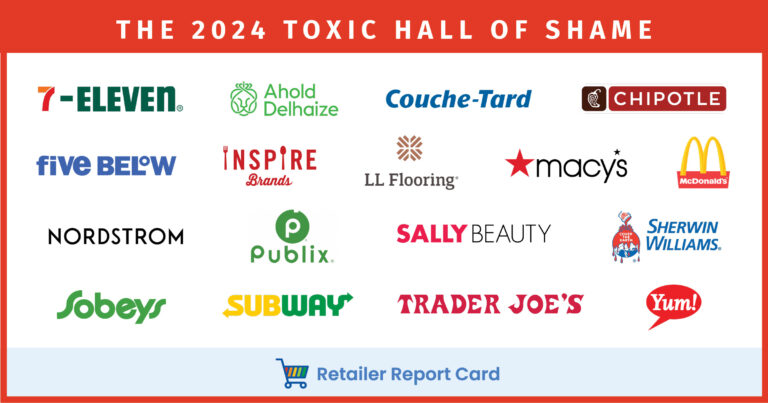Vinyl Chloride
What is vinyl chloride?
Vinyl chloride is the basic building block for making polyvinyl chloride (PVC), a widely-used plastic that harms health and the environment during production, use, and disposal.1, 2 Vinyl chloride is a known human carcinogen associated with liver cancer, brain and lung cancers, and cancers of the blood, and can be found in air, water, and soil.3 Despite the well-documented harms from vinyl chloride, companies continue to produce the chemical and use it to make PVC pipes, packaging materials, cars, children’s toys, and building materials like wall and floor coverings.
How am I exposed to vinyl chloride?
Vinyl chloride has been detected in environmental samples including air, water, and soil, but the main way people are exposed to vinyl chloride is by breathing contaminated air. Manufacturers of vinyl chloride and PVC release vinyl chloride into air and wastewater, putting people at risk of exposure to this harmful chemical through a variety of different ways.3
- Air: vinyl chloride is detected in air near vinyl chloride manufacturing and processing plants, hazardous waste sites, and landfills. Breathing in contaminated air is one of the primary ways people are exposed to vinyl chloride.3
- Water: vinyl chloride has been detected in groundwater, surface water, and drinking water, often near production sites and landfills. Water contaminated with vinyl chloride can also contaminate indoor air when the water is used for showering, cooking, or laundry.4, 5
- Consumer products: vinyl chloride can be emitted from PVC/vinyl products. For example, elevated levels of vinyl chloride have been measured inside of new cars with vinyl interiors. Vinyl chloride is also known to leach from PVC bottles, pipes, and food-contact materials.2, 3, 6, 7
Why should I be concerned?
From production to disposal, vinyl chloride threatens health and contaminates the environment. The International Agency for Research on Cancer (IARC), U.S. Department of Health and Human Services (HHS), and the U.S. Environmental Protection Agency (EPA) have all identified vinyl chloride as a known human carcinogen.8 More than 10 billion pounds of vinyl chloride are produced in the U.S. each year, with approximately 99% used to produce PVC and its copolymers.9, 10 Many vinyl chloride facilities are located in communities with more residents who are people of color and/or lower-income, resulting in disproportionate exposure to vinyl chloride emissions.11 Breakdown of vinyl chloride can lead to the formation of formaldehyde, and burning it such as in an incinerator generates dioxins.3, 11
Health effects of vinyl chloride:
- Cancer: vinyl chloride is associated with liver cancer, lung and brain cancer, lymphoma, leukemia, and breast cancer.1, 3, 12
- Acute exposure: exposure to higher concentrations of vinyl chloride exposure can cause dizziness, fatigue, drowsiness, headache, and loss of consciousness.13
- Chronic exposure: repeated exposure to vinyl chloride can cause liver injury and liver cancer, neurologic or behavioral symptoms, and vinyl chloride disease, a syndrome that consists of Raynaud’s phenomenon (blanching, numbness, and discomfort of the fingers upon exposure to cold), degeneration of the bones in the fingertip and lower back, and skin changes.6, 13
Impacts of vinyl chloride on vulnerable populations:
- Children can have greater exposure due to their higher lung surface area to body weight ratio and higher concentrations of vinyl chloride closer to the ground. In addition, more kids may live near point sources: research has found that in the population living within three miles of PVC production and disposal sites, 27% are children, compared to the national average of 22%.11
- Workers at vinyl chloride facilities or facilities that make PVC are exposed by breathing in vinyl chloride but can also be exposed through their skin and eyes. Workplace exposure has been known to cause cancer and other types of liver disease.1, 14
- People of color and low-income communities may have greater exposure. Many PVC manufacturing plants and disposal sites are located within low-income areas and communities of color, exposing vulnerable communities to harmful chemicals. Communities living within a three-mile radius of PVC plants are 63% people of color and earn an average of $23,747 per capita, compared to the national averages of 41% people of color and average income of $37,638.11
Which companies manufacture vinyl chloride?
There are more than 10 vinyl chloride facilities in the United States; since 2016 these manufacturers have produced a total of 10-20 billion pounds of vinyl chloride per year.9, 15 Toxic-Free Future’s PVC Poison Plastic report found that five chemical corporations contribute more than 97% of vinyl chloride releases to the air in the United States: Westlake Chemical, Formosa Plastics, Occidental Chemical, Shintech, and Orbia (Mexichem). These companies manufacture chemicals for PVC plastic building materials and consumer products, and along with Ineos in Europe and several other companies in China, they are the biggest producers of vinyl chloride globally.
How can I reduce my exposure?
- Choose household items, clothing, and building materials that are PVC-free. Items commonly made with PVC include flooring, pipes, wallpaper, upholstery, shower curtains, wire and cable coatings, raingear, and toys.
- Avoid food-contact materials or water bottles that contain PVC.
- If there was a vinyl chloride spill near you, or if you are concerned about vinyl chloride contamination in your community, look into testing services to check your air and water for presence of vinyl chloride. Vinyl chloride can contaminate indoor air through soil vapor intrusion16, and other chlorinated chemicals (such as trichloroethylene) can degrade into vinyl chloride in groundwater.17
What’s the solution?
Since nearly all vinyl chloride is produced for manufacture of PVC, the number one way to reduce vinyl chloride exposure is to move away from PVC products. Government agencies and companies should enact policies to end the use of PVC wherever safer alternatives are available.
Companies shouldn’t sell products with dangerous chemicals or plastics — especially as scientists continue to learn more about the “silent epidemic” caused by the cumulative impact of all the toxic chemicals we are regularly exposed to. And our state and federal governments shouldn’t allow chemicals on the market until they’re proven safe.
The only way to protect everyone from toxic chemicals like vinyl chloride is to change policies at government and corporate levels to make sure that safer solutions are the norm.
We’re fighting every day to protect you and your loved ones from toxic chemicals like this. To join our fight, please consider making a donation, taking action with us, or signing up for our email list.
Our Key Projects
Healthy Choices
Take Action


Endnotes:
- National Cancer Institute. “Vinyl Chloride.” https://www.cancer.gov/about-cancer/causes-prevention/risk/substances/vinyl-chloride#:~:text=Vinyl%20chloride%20is%20used%20primarily%20to%20make%20polyvinyl%20chloride%20(PVC,a%20known%20or%20suspected%20carcinogen.)
- Environmental Protection Agency. “Vinyl Chloride and Health FAQ Document.” https://www.epa.gov/system/files/documents/2023-06/Vinyl-Chloride-and-Health-FAQ-Document-5-31-508.pdf
- Agency for Toxic Substances and Disease Registry, “Public Health Statement Vinyl Chloride,” 2006. [Online]. Available: https://www.atsdr.cdc.gov/ToxProfiles/tp20-c1-b.pdf
- Minnesota Department of Health, “Vinyl Chloride and Drinking Water,” 2016. [Online]. Available: https://www.health.state.mn.us/communities/environment/risk/docs/guidance/gw/vinylchlorideinfo.pdf
- Illinois Department of Public Health. “Vinyl Chloride in Groundwater.” https://dph.illinois.gov/topics-services/environmental-health-protection/private-water/fact-sheets/vinyl-chloride-groundwater.html
- Environmental Protection Agency, “Vinyl chloride,” 2000. [Online]. Available: https://19january2017snapshot.epa.gov/sites/production/files/2016-09/documents/vinyl-chloride.pdf
- M. Wilcox, “The Perils of PVC Plastic Pipes,” Beyond Plastics, 2023. [Online]. Available: https://static1.squarespace.com/static/5eda91260bbb7e7a4bf528d8/t/6491ce414930f2385aedb80c/1687277125680/The_Perils_of_PVC_Plastic_Pipes-April_2023_Digital.pdf
- Agency for Toxic Substances and Disease Registry. “ToxFAQs™ for Vinyl Chloride.” https://wwwn.cdc.gov/TSP/ToxFAQs/ToxFAQsDetails.aspx?faqid=281&toxid=51#:~:text=of%20the%20fetus.-,Can%20vinyl%20chloride%20cause%20cancer%3F,the%20inhalation%20route%20of%20exposure.
- United States Environmental Protection Agency. 2020 CDR Nationally Aggregated Production Volumes.
- E.-L. Dreher, K. K. Beutel, J. D. Myers, T. Lübbe, S. Krieger, and L. H. Pottenger, “Chloroethanes and Chloroethylenes,” Ullmann’s Encyclopedia of Industrial Chemistry, 2014, doi: https://doi.org/10.1002/14356007.o06_o01.pub2.
- M. Schade, “PVC Poison Plastic,” 2023. [Online]. Available: https://toxicfreefuture.org/wp-content/uploads/2023/04/Report-PDF-PVC-Poison-Plastic-Investigation-4.pdf
- E. Garcia, S. Hurley, D. O. Nelson, A. Hertz, and P. Reynolds, “Hazardous air pollutants and breast cancer risk in California teachers: a cohort study,” Environ Health, vol. 14, p. 14, Jan 30 2015, doi: 10.1186/1476-069X-14-14.
- Agency for Toxic Substances and Disease Registry. “Medical Management Guidelines for Vinyl Chloride.” https://wwwn.cdc.gov/TSP/MMG/MMGDetails.aspx?mmgid=278&toxid=51#:~:text=The%20primary%20target%20of%20vinyl,mucous%20membranes%2C%20and%20respiratory%20tract.
- U. Fedeli, P. Girardi, and G. Mastrangelo, “Occupational exposure to vinyl chloride and liver diseases,” World J Gastroenterol, vol. 25, no. 33, pp. 4885-4891, Sep 7 2019, doi: 10.3748/wjg.v25.i33.4885.
- Environmental Protection Agency. 2020 Manufacture-Import Information.
- New York State Department of Health. “Tenant Notification Fact Sheet for Vinyl Chloride.” https://www.health.ny.gov/environmental/indoors/air/contaminants/vinyl_chloride.htm
- Illinois Environmental Protection Agency, “Fact Sheet 1, Trichloroethylene (TCE) Groundwater Contamination Investigation Eastern Lisle and Nearby Affected Areas.” [Online]. Available: https://epa.illinois.gov/topics/community-relations/sites/lisle-groundwater/fact-sheet-1.html.




